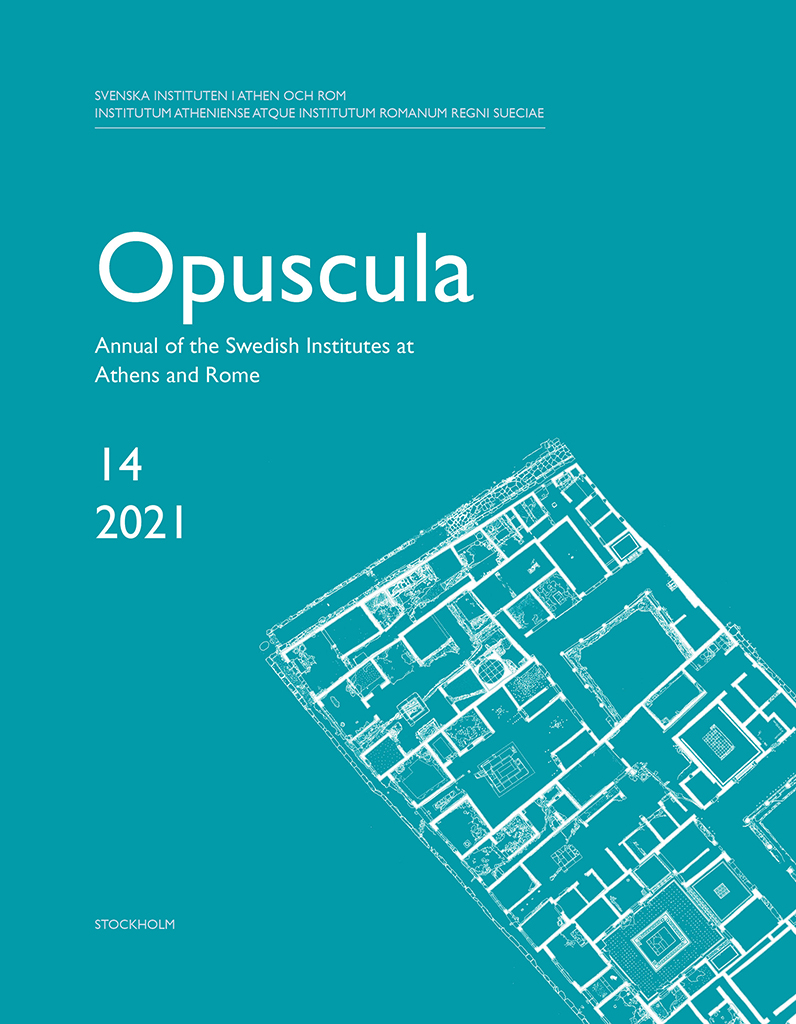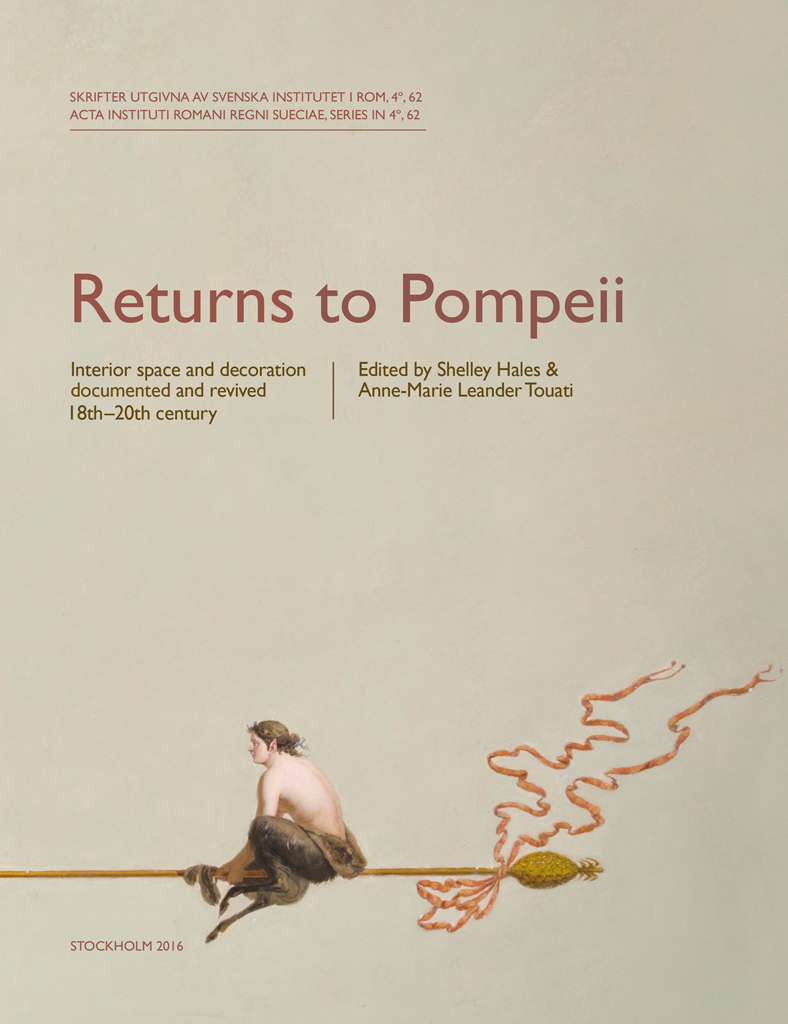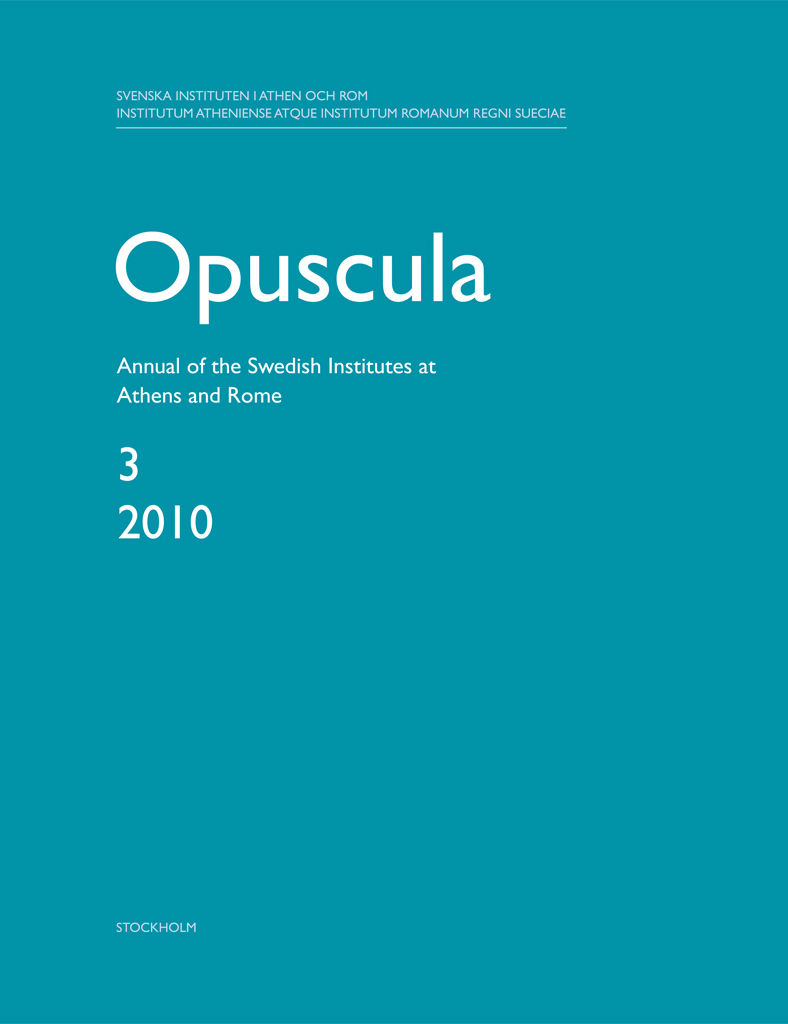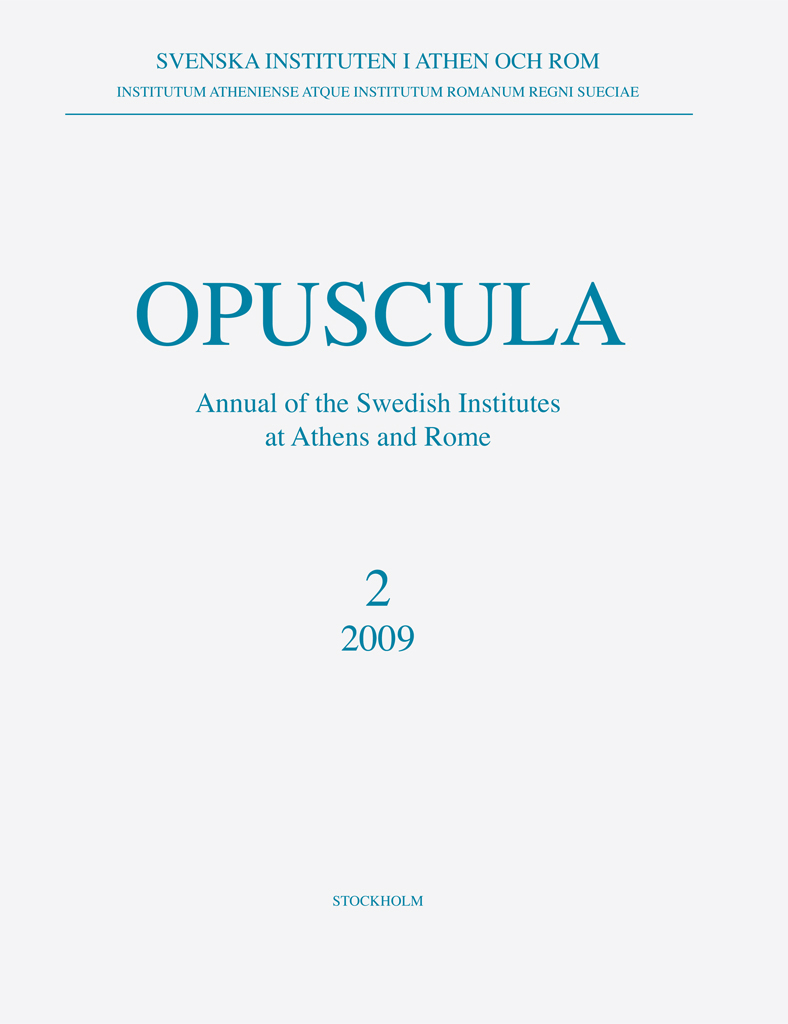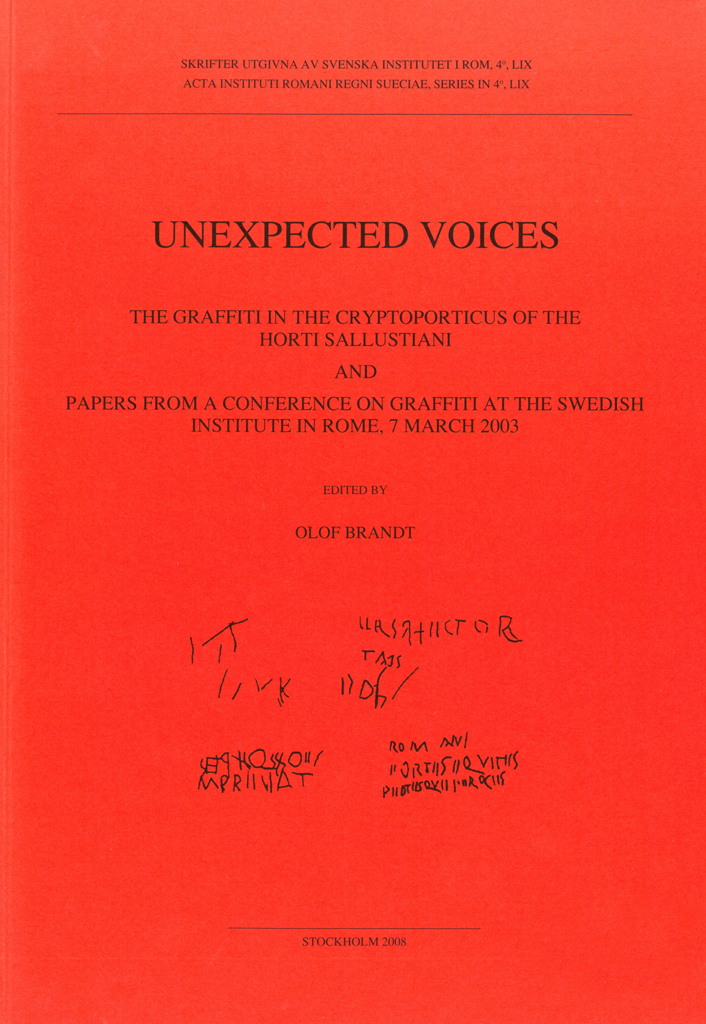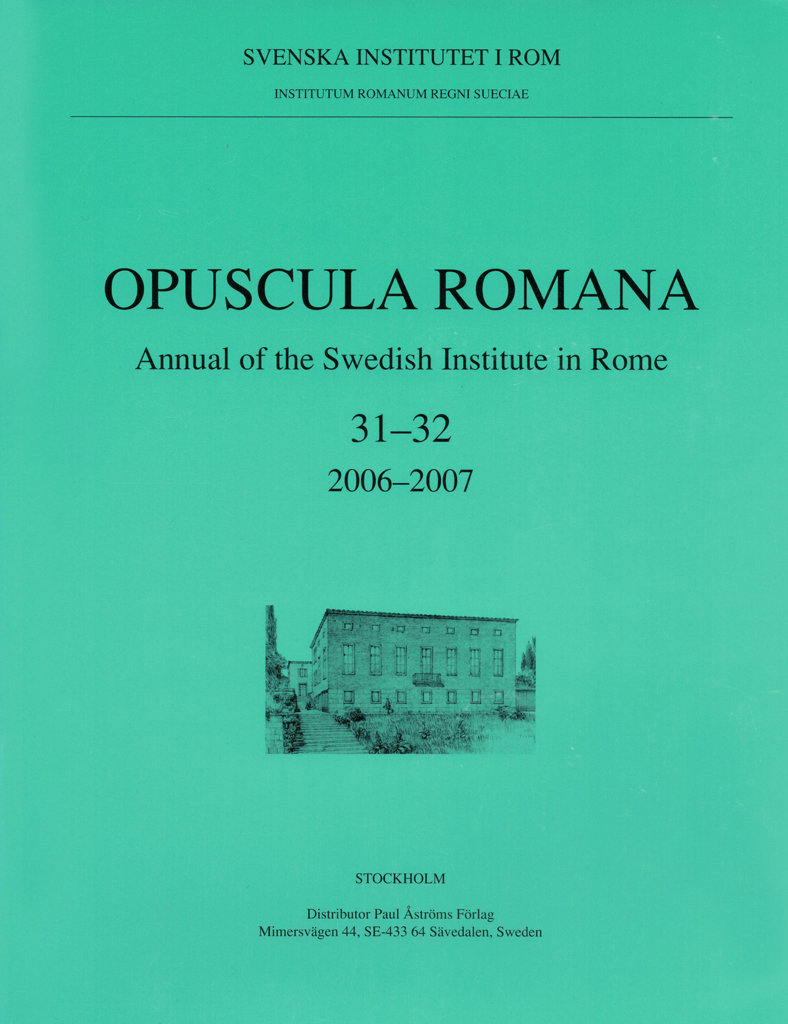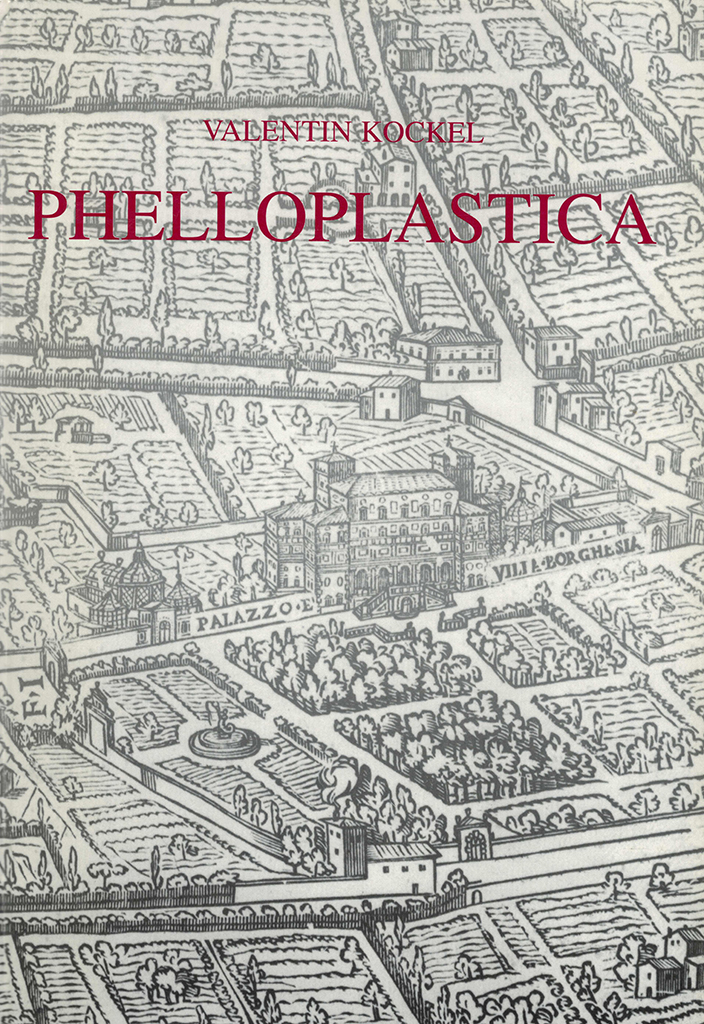Opuscula is published by the Swedish Institutes at Athens and Rome, with the aid of a grant from the Swedish Research Council. Distributed by Eddy.se AB. View journal at ERIH PLUS. All content available with open access. Building the social. A query into the societal impact of the Pompeian water supply By Anne-Marie Leander Touati (Lund University) Abstract This study explores the importance of the means of ensuring water supply in the formation of the architectural profile and basic social organization of Pompeii. It sees the city’s domestic water supply, for over two centuries ensured through rainwater-harvesting areas, basins and cisterns situated mainly in and below the many atria, as a stabilizing factor of both cityscape and household. Through the introduction of the city aqueduct in the 1st century AD and the creation of a generous network of public fountains this situation changes and the need to maintain the traditional organization of the “houseful”, comprising enlarged family, slaves and dependents of various kind including shopkeepers, is lessened; the physical proximity between those of different status renegotiated. This development, witnessed in adaptations of the architecture, can be followed through close study of the standing structures in Insula V 1. The hallmarks are…
Opuscula is published by the Swedish Institutes at Athens and Rome, with the aid of a grant from the Swedish Research Council. Distributed by Eddy.se AB. View journal at ERIH PLUS. All content available with open access. From 2D and 3D documentation to 4D interpretation. Building archaeological conclusions and workflow strategies gained by remote study of Insula V 1, Pompeii By Anne-Marie Leander Touati (Lund University, Sweden), Thomas Staub (Lund University, Sweden) & Renée Forsell (Lund University, Sweden) Abstract The text describes new methods elaborated for and used in the building archaeological assessment of a city block, studied first on site, then remotely by members of the Swedish Pompeii Project. Use of a digital platform, with collected wall observations and analysis, systematic photographic documentation of all standing structures, and 3D models, allowed discussion to proceed after the fieldwork came to an end. The models provided new possibilities and new angles of approach, e.g. examining walls at any given point, studying boundary walls as wall-strings in their full extent, allowing all kinds of sectioning at will, introducing bird’s-eye views as a new perspective in study, and measuring wherever needed. The joint results obtained are summed up in a four-phase development of the…
Published by the Swedish Institute of Classical Studies in Rome. Distributed by Eddy.se AB. Returns to Pompeii. Interior space and decoration documented and revived. 18th–20th century Edited by Shelley Hales & Anne-Marie Leander Touati Abstract This volume presents a series of case studies that trace the ways in which audiences across Europe have attempted to return to Pompeii by emulating its interior decorations since the city’s rediscovery in the mid-eighteenth century. As such, it is about both the impact of Pompeian antiquity on the present and the reception in the present of that antique past, exploring the variety of ways in which Pompeian domestic space and decoration have been revived (and for what purposes and audiences). The contributions to the volumes compare the ways in which Pompeian wall decorations were interpreted and adapted, given new context and put to serve new social and political purposes, both close to their place of discovery, in the Kingdom of Naples, and in the far-off European periphery, represented by Denmark and Sweden. The many images presented to the reader in this volume confirm colour, fantasy and playfulness, alongside an almost academic orthodoxy of structure, as trademarks of a defined neo-Pompeian style. The volume brings…
Opuscula is published by the Swedish Institutes at Athens and Rome, with the aid of a grant from the Swedish Research Council. Distributed by Eddy.se AB. View journal at ERIH PLUS. Content available with open access. Water, well-being and social complexity in Insula V 1. A Pompeian city block revisited By Anne-Marie Leander Touati Abstract Swedish archaeologists have been working in Pompeii since 2000. Our fieldwork has consisted mainly of the study of standing walls and cleared floor levels in a city block unearthed in the 19th century and of the production of a comprehensive documentation, presented in an open access publication: www.pompejiprojektet.se/insula.php. The perspective of the present paper is the insula as a whole. Its main study objects are features of recurrent nature that in varying form and frequency are found in many of the separate houses and other units that constitute this insula: for example, the divergent materials used for the rubble masonry in the first phase of urbanisation, structures used for water management such as water supply and drains, possible earthquake damage and resulting repairs, preferences for where kitchens and sanitary installations are placed, markers indicating property borders and dependencies such as pavement curbing, courses of water…
Opuscula is published by the Swedish Institutes at Athens and Rome, with the aid of a grant from the Swedish Research Council. Distributed by Eddy.se AB. View journal at ERIH PLUS. All content available with open access. Decorative effects and room functions. The evidence of thresholds studied in the residential quarters of Insula V 1, Pompeii By Thomas Staub Abstract The present paper discusses the use of different types of thresholds in the Pompeian domestic architecture. The considerations proceed from observations made in three larger dwellings in Insula V 1 in Pompeii, the town quarter, which is under current investigation by the Swedish Pompeii Project. The thresholds are considered in the contexts of corresponding pavements and wall decorations as well as that of the related rooms. Differences will be studied between the areas around the atria and the zones around the peristyles. They indicate that while the thresholds around the atrium are of a homogeneous character, defined by the shape and decorations of the central room, the ones around the peristyle are defined by the decorations and dignity of each particular room opening up towards the central entity. It seems also that both the material used and the shape of…
Published by the Swedish Institute of Classical Studies in Rome. Distributed by Eddy.se AB. Unexpected voices. The graffiti in the cryptoporticus of the Horti Sallustiani and papers from a conference on graffiti at the Swedish Institute in Rome, 7 march 2003 Edited by Olof Brandt Abstract This volume presents the results of a collaboration between the Swedish Institute in Rome and the Embassy of the United States of America in Rome. The object of the research was a cryptoporticus, part of the ancient Horti Sallustiani, in the area of the American Embassy, and especially the graffiti found on the walls of the cryptoporticus, which were also decorated with paintings. The cryptoporticus, which is dated to the first century AD, was excavated in 1949–1950 and in the 1990s, but the graffiti have never been completely published. In this publication, all the graffiti are discussed and dated. Some belong to Late Antiquity, others were made in the 16th and 17th centuries. The study of these graffiti gives important information about the later fate of the first-century cryptoporticus. Several unpublished fragments of wall-paintings are also presented, and more general historic and archaeological aspects of the cryptoporticus are discussed. Part of the project was…
Published by the Swedish Institute of Classical Studies in Rome. Distributed by Eddy.se AB. Opuscula Romana. Annual of the Swedish Institute in Rome 31–32, 2006–2007 Contents Johnny R. Bengtsson | Late Bronze Age handles from the Apennine settlement at Luni sul Mignone: Some chronological observations Ingela M.B. Wiman & Yvonne Backe-Forsberg | Surfacing deities in later Etruscan art and the sacellum at San Giovenale Allan Klynne | The Villa Selvasecca revisited John W. Hayes | Villa Selvasecca: the pottery finds Ebba Engström & Ragnar Hedlund | Villa Selvasecca: the coins Dominic Ingemark | Villa Selvasecca: the glass Anne-Marie Leander Touati | Interim report of the Swedish Pompeii Project: Work 2000–2004/5 in Insula V 1. Introduction Margareta Staub Gierow | The House of the Greek Epigrams V 1,18.11–12: preliminary report 2000–2004 Arja Karivieri & Renée Forsell | The House of Caecilius Iucundus, V 1,22–27: a preliminary report Henrik Boman & Monica Nilsson | The commercial establishments V 1,13; V 1, 14–16; V 1,20–21: preliminary report 2001–2004 Mark Robinson | Evidence for garden cultivation and the use of bedding-out plants in the peristyle garden of the House of the Greek Epigrams (V 1, 18i) at Pompeii Henrik Boman & Monica Nilsson |…
Published by the Swedish Institute of Classical Studies in Rome. Distributed by Astrom Editions. Opuscula Romana. Annual of the Swedish Institute in Rome 30, 2005 Contents Anne-Marie Leander Touati | The Piranesi marbles from Rome to Stockholm. An introduction to research in progress (pp. 7–29) Raffaela Bosso | Osservazioni sull’attività della bottega Piranesi tra Giovanni Battista e Frencesco: il caso esemplare del gruppo di candelabri con trampolieri (pp. 31–62) Dietrich Boschung & Glenys Davies | Arae Passieniorum (pp. 63–72) G.F. Guidi, C. Giardino & G. Trojsi | L’insediamento etrusco di San Giovenale (Blera, Vitterbo). Caratterizzazione chimico-fisica dei residui delle attività produttive (pp. 73–84) Kristina Jonsson | Intra mural graves in Rome. Social dimensions in early medieval burial practices (pp. 85–95) Monica Nilsson & Mark Robinson | Remains of prehistoric habitation beneath Pompeii V 1,13 (pp. 97–103) Bengt E. Thomasson | Laterculi praesidium. Addendorum series quarta (pp. 105–122) Book reviews Örjan Wikander | L. Ambrosini, Thymiateria etruschi in bronzo di età tardo classica, alto e medio ellenistica (pp. 123–131) Izabella Donkow | B. Burell, Neokoroi: Greek cities and Roman emperors (pp. 132–133) Bibliographical information Opuscula Romana. Annual of the Swedish Institute in Rome 30, Stockholm 2006. ISSN 0471-7309. ISBN 91-7042-173-0. Softcover,…
Published by the Swedish Institute of Classical Studies in Rome. Distributed by Astrom Editions. Phelloplastica. Modelli in sughero dell’architettura antica nel XVIII secolo nella collezione di Gustavo III di Svezia By Valentin Kockel, with a contribution by Magnus Olausson Abstract This volume treats the art of making cork models of ancient architecture in the work of Giovanni Altieri, one of the best-known modellers of the 18th century. It was from him that the Swedish king Gustavus III bought all his models. A popular method of reproducing the ruins of Rome three-dimensionally, and of introducing them into central and northern Europe, was cork models. These may be compared to plaster casts or small-scale copies of ancient sculpture. Because of its porosity, cork proved optically ideal for the portrayal of ancient ruins, and it could also be easily transported, as it was so light. The craftsmanship follows the tradition of the Nativity artisans of Naples. Travellers to Italy valued the cork models as representations of widely admired Roman architecture and could also transfer to them their fascination for the ruins, which were seen as symbols of transience. Nos. 1–5 of the catalogue depict buildings from Rome and Tivoli that also constituted the…


